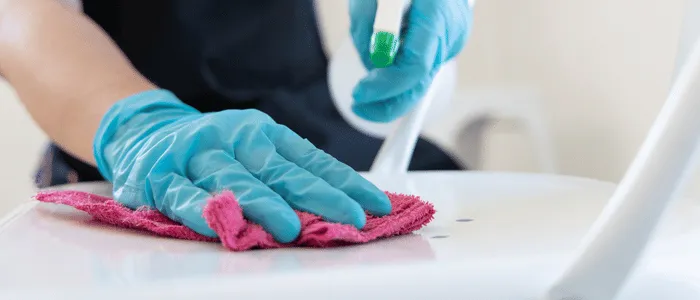Blogs

Why Using the Right Bathroom Disinfectant Matters
Why Using the Right Product to Disinfect Your Bathroom Matters
When was the last time you really thought about what you're using to clean your bathroom? Most of us just grab the nearest spray bottle, scrub a little, rinse, and move on. But what if I told you that using the wrong product could actually be doing more harm than good? Yep — the truth is, not all disinfectants are created equal. Some may kill germs, but leave behind residue. Others smell fresh but don’t actually sanitize anything.
In this blog, we’re going to break down why choosing the right disinfectant is not just smart — it’s essential. Think of your bathroom like a mini battlefield. The right weapon (aka disinfectant) makes all the difference between a clean victory and a hidden disaster.
Let’s dive in and discover how to keep your bathroom really clean — not just looking clean.
1. Why Disinfecting Matters
Let’s be real: the bathroom is where the dirty business happens. That makes it ground zero for germs and bacteria. Disinfecting is more than just wiping up messes — it’s about protecting your health and the health of everyone in your home.
2. The Difference Between Cleaning and Disinfecting
This one’s a game-changer. Cleaning means removing dirt and grime — it looks better. Disinfecting means killing germs — it makes it safer. You can clean without disinfecting, but you can’t disinfect properly without cleaning first.
3. Common Bathroom Germs You Should Know About
Ever heard of E. coli or staphylococcus? These bad boys love hanging out in your bathroom — especially on the toilet seat, faucet handles, and even toothbrush holders. Gross, right? That’s why your disinfectant needs to target these specific threats.
4. What Makes a Product “Right” for Disinfecting?
The right disinfectant does three things:
Kills bacteria and viruses effectively
Safe for surfaces and people (especially kids and pets!)
Leaves no harmful residue
If it checks all three, you’ve got a winner.
5. The Role of Active Ingredients
Ever looked at the back of the bottle and felt like you were reading a foreign language? The active ingredient is what does the germ-killing. Look for:
Sodium hypochlorite (bleach) – great for tough jobs, but harsh
Hydrogen peroxide – effective and gentler
Quats (quaternary ammonium compounds) – common in commercial products Knowing your ingredients is like knowing the ingredients in your food — it matters!
6. How to Read Disinfectant Labels
Reading labels isn’t just for food. Check for:
Kill claims (what germs it targets)
Contact time (how long it needs to sit)
EPA registration (proves it’s legit) If it promises to kill 99.9% of germs, make sure it can actually back that up.
7. The Dangers of Using the Wrong Product
Using the wrong disinfectant is like going into battle with a plastic spoon. You might make a dent, but you’re not winning the war. Plus, some products can:
Damage surfaces
Release harmful fumes
Trigger allergies or asthma
Fail to kill key bacteria and viruses Not exactly the clean victory you were hoping for.
8. Natural vs Chemical Disinfectants: Which is Better?
Natural disinfectants like vinegar or essential oils sound great, but they may not be strong enough for bathroom-grade messes. Chemical disinfectants get the job done, but can be harsh. The trick? Balance. Use natural options for daily wipe-downs, and chemical ones for weekly deep cleans.
9. How to Disinfect Different Bathroom Surfaces
Each surface needs its own approach:
Toilet – Use bleach or a strong disinfectant; don’t forget under the rim
Sink & faucet – Focus on handles and basin; these get touched constantly
Shower & tub – Use a mold and mildew fighter; let it sit!
Mirrors & counters – Use alcohol-based spray that won’t streak
And don’t forget about the floor, especially if you have rugs or mats. Dirt, bacteria, and moisture love to hide there — and over time, that buildup can spread germs throughout the room. Regular vacuuming and proper carpet cleaning can make a huge difference. If you're interested in learning more about the importance of clean carpets, this article on why carpet cleaning is necessary offers some eye-opening insights.
10. Disinfecting Tips for High-Touch Areas
Think beyond the obvious:
Light switches
Doorknobs
Toilet handles
Cabinet pulls
Towel holders These are germ highways. Give them a daily spritz of disinfectant.
11. How Often Should You Disinfect Your Bathroom?
Here’s a simple guide:
Toilet – Every other day
Sink & faucet – Daily
Shower & tub – Weekly
High-touch areas – Daily or every other day A little consistency goes a long way.
12. Eco-Friendly Disinfecting Options
Want to be clean and green?
Look for biodegradable ingredients
Choose refillable bottles
Use cloth rags instead of paper towels Your bathroom (and planet) will thank you.
13. Product Recommendations for Every Need
Here are some reliable options:
Clorox Disinfecting Bathroom Cleaner – bleach-based, powerful
Lysol Hydrogen Peroxide Bathroom Cleaner – no bleach, good for kids
Seventh Generation Disinfectant Spray – plant-based and EPA-approved Each has its pros. Choose what works best for your home and family.
14. Disinfecting Myths You Probably Believe
Let’s bust a few:
“Bleach cleans everything” – nope, it can corrode some surfaces
“If it smells clean, it is clean” – not always
“More disinfectant means more power” – only if you let it sit the right amount of time
15. Conclusion: Health Starts with the Right Choice
Disinfecting your bathroom isn’t just about making it look nice — it’s about keeping it safe. Choosing the right product is like putting on armor before going into battle. You wouldn’t go into war unprepared — so don’t clean your bathroom unarmed.
The right disinfectant kills the right germs, protects your loved ones, and helps you sleep a little easier at night. So next time you’re picking a product, take a moment to read that label and make the smart choice.
FAQs
1. What’s the difference between disinfecting and sanitizing?
Sanitizing reduces germs to a safe level, while disinfecting kills most germs completely. For bathrooms, disinfecting is the better option.
2. Can I use vinegar to disinfect my bathroom?
Vinegar can clean surfaces, but it's not approved as a disinfectant for killing viruses or bacteria in bathrooms.
3. Is it okay to mix bleach with other cleaners?
No! Mixing bleach with other chemicals (especially ammonia) can release toxic gases and is very dangerous.
4. How long should I let a disinfectant sit on a surface?
Always follow the label — but generally, 5 to 10 minutes is ideal to kill most germs effectively.
5. Are natural disinfectants safe and effective?
Some are safe, but not all are effective against bathroom germs. Look for EPA-approved products that are labeled as disinfectants.
Contact Us
Need a trusted and professional cleaning service for your business? We’re here to help! Contact Personal Smart Services today and let’s create a cleaner, healthier space for your workplace.
📞 Phone: (508) 978-3003
📧 Email: [email protected]
🕒 Business Hours:
Monday – Saturday: 9:00am - 8:00pm
Sunday: Closed
Fill out the form, and our team will get back to you as soon as possible!
Make a Call



